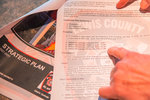



As the weather warms up and wildfire risk increases statewide, homeowners are encouraged to do a quick survey of their property and take some simple steps to help protect their homes from wildfire.
Lewis County fire districts and the Department of Natural Resources (DNR) have assembled an array of educational materials for property owners on defensible space — the buffer between a structure and ignitable materials such as trees or shrubs — and what they can do to help firefighters protect their property in the event of a wildfire.
In Lewis County Fire District 6 Chief Ken Cardinale’s experience, actions as simple as moving a broomstick off the porch or cleaning dead pine needles out of gutters can determine whether or not a structure survives a wildfire.
“Embers land and anything that’s combustible around the home can start an ignition,” he said.
In most cases where structures are destroyed in a wildfire, “it’s not the big flames that are coming through and destroying homes, it’s embers,” he said.
Cardinale related the behavior of those embers to snowflakes: they travel with the wind and settle on surfaces. And if the surface they land on happens to be flammable, then it’s going to ignite.
Simple actions homeowners can take to prevent their homes from igniting in a wildfire include cleaning up dead vegetation on and around the home and checking to make sure that there’s nothing flammable within 5 feet of the structure’s exterior walls. This includes items stored on or under a deck and items stored in an attic that has an exterior vent.
Living plants or trees don’t necessarily need to be removed, but limbing up trees, trimming grass and cleaning out any dead material collected in shrubs can significantly reduce a structure’s wildfire risk.
“By doing all that (preparation), that makes the home so much easier to protect,” Cardinale said.
Educational materials, including a home ignition zone structure assessment guide, are currently available at District 6’s fire stations, and Cardinale has plans to hold defensible space classes for community members later this summer.
Firefighters encourage anyone with questions about protecting their own properties to reach out.
If they’re available, someone from the fire station can even walk with homeowners around their property and help them assess what the possible fire hazards are and how to address them.
In addition to reducing their home’s fire risk, homeowners are encouraged to check to make sure firefighters have an easy way to get in and out of their neighborhood, should they need to.
Cardinale recalled one of his first firefighting experiences as a rookie in California — the Oakland Hills firestorm of 1991 — as an example of what could happen if firefighters aren’t able to quickly get in or out of an area.
In that fire, which killed 25 people and destroyed over 3,000 homes, the affected suburbs were built on steep hills with narrow streets, and firefighters faced the added difficulties of cars blocking the streets and preventing crews from accessing fire hydrants.
Lewis County Alert
All Lewis County residents are advised to sign up for Lewis County Alert, the county’s local emergency alert and notification system.
The system sends out text, email and phone alerts pertaining to fires, severe weather, police and health and safety emergencies. In the event of a wildfire, the alert system is how fire incident commanders will order evacuations.
Residents can sign up for Lewis County Alert online at www.lewiscountywa.gov/departments/emergency-management/lewis-county-alert.
While fire personnel or police officers cannot force anyone to evacuate, Cardinale strongly encourages residents not to ignore evacuation orders.
“We will never call evacuations unless they’re needed,” he said. “It's important that when we issue those evacuation orders, people need to get out.”
The most common reason why people choose not to leave, Cardinale said, is the false belief that they can protect their homes.
But, Cardinale said, these homeowners don’t have the same gear, training and experience that the trained firefighters have, and are only putting themselves in unnecessary danger if they decide to stay.
“We’re telling them to leave for a reason,” he said.
Incident commanders try to issue evacuation orders early so that law enforcement have time to help people safely evacuate and get themselves out before they’re in significant danger, Cardinale said.
“We do our best estimate on how fast the fire is moving,” he said, adding that it’s not uncommon for fires to move very quickly, and people need to start evacuating as soon as they receive an evacuation order.
People are also asked not to stop and take photos of firefighters or smoke plumes on their way out, as their presence can interfere with firefighting activities.
For more information about how to prepare your home and family for fire season, visit www.dnr.wa.gov/WildfirePrevention or contact Lewis County Fire District 6 at 360-748-6019.
District 6 serves the communities of rural Chehalis and Adna.